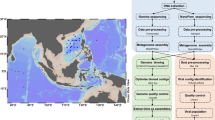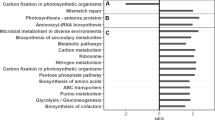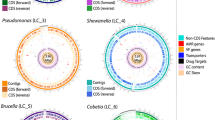Abstract
Prochlorococcus is a genus of abundant and ecologically important marine cyanobacteria. Here, we present a comprehensive comparison of the structure and composition of the transcriptomes of two Prochlorococcus strains, which, despite their similarities, have adapted their gene pool to specific environmental constraints. We present genome-wide maps of transcriptional start sites (TSS) for both organisms, which are representatives of the two most diverse clades within the two major ecotypes adapted to high- and low-light conditions, respectively. Our data suggest antisense transcription for three-quarters of all genes, which is substantially more than that observed in other bacteria. We discovered hundreds of TSS within genes, most notably within 16 of the 29 prochlorosin genes, in strain MIT9313. A direct comparison revealed very little conservation in the location of TSS and the nature of non-coding transcripts between both strains. We detected extremely short 5′ untranslated regions with a median length of only 27 and 29 nt for MED4 and MIT9313, respectively, and for 8% of all protein-coding genes the median distance to the start codon is only 10 nt or even shorter. These findings and the absence of an obvious Shine–Dalgarno motif suggest that leaderless translation and ribosomal protein S1-dependent translation constitute alternative mechanisms for translation initiation in Prochlorococcus. We conclude that genome-wide antisense transcription is a major component of the transcriptional output from these relatively small genomes and that a hitherto unrecognized high degree of complexity and variability of gene expression exists in their transcriptional architecture.
Similar content being viewed by others
Log in or create a free account to read this content
Gain free access to this article, as well as selected content from this journal and more on nature.com
or
Accession codes
References
Axmann IM, Kensche P, Vogel J, Kohl S, Hess WR . (2005). Identification of cyanobacterial non-coding RNAs by comparative genome analysis. Genome Biol 6: R73.
Boni IV, Isaeva DM, Musychenko ML, Tzareva NV . (1991). Ribosome-messenger recognition: mRNA target sites for ribosomal protein S1. Nucleic Acids Res. 19: 155–162.
Bonnet E, Wuyts J, Rouzé P, Van de Peer Y . (2004). Evidence that microRNA precursors, unlike other non-coding RNAs, have lower folding free energies than random sequences. Bioinformatics 20: 2911–2917.
Dufresne A, Salanoubat M, Partensky F, Artiguenave F, Axmann IM, Barbe V et al. (2003). Genome sequence of the cyanobacterium Prochlorococcus marinus SS120, a nearly minimal oxyphototrophic genome. Proc Natl Acad Sci USA 100: 10020–10025.
Fröhlich KS, Papenfort K, Berger AA, Vogel J . (2012). A conserved RpoS-dependent small RNA controls the synthesis of major porin OmpD. Nucleic Acids Res 40: 3623–3640.
Garczarek L, Partensky F, Irlbacher H, Holtzendorff J, Babin M, Mary I et al. (2001). Differential expression of antenna and core genes in Prochlorococcus PCC 9511 (Oxyphotobacteria) grown under a modulated light-dark cycle. Environ Microbiol 3: 168–175.
Georg J, Voss B, Scholz I, Mitschke J, Wilde A, Hess WR . (2009). Evidence for a major role of antisense RNAs in cyanobacterial gene regulation. Mol Syst Biol 5: 1–17.
Georg J, Hess WR . (2011). cis-antisense RNA, another level of gene regulation in bacteria. Microbiol. Mol Biol Rev 75: 286–300.
Goericke R, Welschmeyer NA . (1993). The marine prochlorophyte Prochlorococcus contributes significantly to phytoplankton biomass and primary production in the Sargasso Sea. Deep Sea Res 40: 2283–2294.
Grote J, Thrash JC, Huggett MJ, Landry ZC, Carini P, Giovannoni SJ et al. (2012). Streamlining and core genome conservation among highly divergent members of the SAR11 clade. MBio 3: pii: e00252–12.
Harismendy O, Ng PC, Strausberg RL, Wang X, Stockwell TB, Beeson KY et al. (2009). Evaluation of next generation sequencing platforms for population targeted sequencing studies. Genome Biol. 10: R32.
Hoffmann S, Otto C, Kurtz S, Sharma C, Khaitovich P, Vogel J et al. (2009). Fast Mapping of Short Sequences with Mismatches, Insertions and Deletions Using Index Structures. PLoS Comput Biol 5: e1000502.
Huelsenbeck JP, Ronquist F . (2001). MRBAYES: Bayesian inference of phylogenetic trees. Bioinformatics 17: 754–755.
Hüttenhofer A, Noller HF . (1994). Footprinting mRNA-ribosome complexes with chemical probes. EMBO J 13: 3892–3901.
Jäger D, Sharma CM, Thomsen J, Ehlers C, Vogel J, Schmitz RA . (2009). Deep sequencing analysis of the Methanosarcina mazei Gö1 transcriptome in response to nitrogen availability. Proc Natl Acad Sci USA 106: 21878–21882.
Johnson ZI, Zinser ER, Coe A, McNulty NP, Woodward EMS, Chisholm SW . (2006). Niche partitioning among Prochlorococcus ecotypes along ocean-scale environmental gradients. Science 311: 1737–1740.
Kamennaya NA, Post AF . (2011). Characterization of cyanate metabolism in marine Synechococcus and Prochlorococcus spp. Appl Environ Microbiol 77: 291–301.
Kettler GC, Martiny AC, Huang K, Zucker J, Coleman ML, Rodrigue S et al. (2007). Patterns and implications of gene gain and loss in the evolution of Prochlorococcus. PLoS Genet 3: e231.
Klein MG, Zwart P, Bagby SC, Cai F, Chisholm SW, Heinhorst S et al. (2009). Identification and structural analysis of a novel carboxysome shell protein with implications for metabolite transport. J Mol Biol 392: 319–333.
Li B, Sher D, Kelly L, Shi Y, Huang K, Knerr PJ et al. (2010). Catalytic promiscuity in the biosynthesis of cyclic peptide secondary metabolites in planktonic marine cyanobacteria. Proc Natl Acad Sci USA 107: 10430–10435.
Li S, Xu M, Su Z . (2010). Computational analysis of LexA regulons in Cyanobacteria. BMC Genomics 11: 527.
Lindell D, Jaffe JD, Coleman ML, Futschik ME, Axmann IM, Rector T et al. (2007). Genome-wide expression dynamics of a marine virus and host reveal features of co-evolution. Nature 449: 83–86.
Martiny AC, Coleman ML, Chisholm SW . (2006). Phosphate acquisition genes in Prochlorococcus ecotypes: evidence for genome-wide adaptation. Proc Natl Acad Sci USA 103: 12552–12557.
Mitschke J, Georg J, Scholz I, Sharma CM, Dienst D, Bantscheff J et al. (2011). An experimentally anchored map of transcriptional start sites in the model cyanobacterium Synechocystis sp. PCC6803. Proc Natl Acad Sci USA 108: 2124–2129.
Moll I, Grill S, Gualerzi CO, Bläsi U . (2002). Leaderless mRNAs in bacteria: surprises in ribosomal recruitment and translational control. Mol Microbiol 43: 239–246.
Moore LR, Coe A, Zinser ER, Saito MA, Sullivan MB, Lindell D et al. (2007). Culturing the marine cyanobacterium Prochlorococcus. Limnol Oceanogr Meth 5: 353–362.
Moore LR, Goericke R, Chisholm SW . (1995). Comparative physiology of Synechococcus and Prochlorococcus: influence of light and temperature on growth, pigments, fluorescence and absorptive properties. Mar Ecol Prog Ser 116: 259–275.
Mutsuda M, Sugiura M . (2006). Translation initiation of cyanobacterial rbcS mRNAs requires the 38-kDa ribosomal protein S1 but not the Shine-Dalgarno sequence: development of a cyanobacterial in vitro translation system. J Biol Chem 281: 38314–38321.
Partensky F, Hess WR, Vaulot D . (1999). Prochlorococcus, a marine photosynthetic prokaryote of global significance. Microbiol Mol Biol Rev 63: 106–127.
Pinto FL, Thapper A, Sontheim W, Lindblad P . (2009). Analysis of current and alternative phenol based RNA extraction methodologies for cyanobacteria. BMC Mol Biol 10: 79.
Piper C, Cotter P, Ross R, Hill C . (2009). Discovery of medically significant lantibiotics. Curr Drug Discovery Technol 6: 1–18.
Raabe CA, Tang T-H, Brosius J, Rozhdestvensky TS . (2014). Biases in small RNA deep sequencing data. Nucleic Acids Res 42: 1414–1426.
Richter AS, Schleberger C, Backofen R, Steglich C . (2010). Seed-based INTARNA prediction combined with GFP-reporter system identifies mRNA targets of the small RNA Yfr1. Bioinformatics 26: 1–5.
Rocap G, Larimer FW, Lamerdin J, Malfatti S, Chain P, Ahlgren NA et al. (2003). Genome divergence in two Prochlorococcus ecotypes reflects Oceanic niche differentiation. Nature 424: 1042–1047.
Sakamoto T, Higashi S, Wada H, Murata N, Bryant DA . (1997). Low-temperature-induced desaturation of fatty acids and expression of desaturase genes in the cyanobacterium Synechococcus sp. PCC 7002. FEMS Microbiol Lett 152: 313–320.
Sakamoto T, Shen G, Higashi S, Murata N, Bryant DA . (1998). Alteration of low-temperature susceptibility of the cyanobacterium Synechococcus sp. PCC 7002 by genetic manipulation of membrane lipid unsaturation. Arch Microbiol 169: 20–28.
Scanlan DJ, Ostrowski M, Mazard S, Dufresne A, Garczarek L, Hess WR et al. (2009). Ecological genomics of marine picocyanobacteria. Microbiol Mol Biol Rev 73: 249–299.
Schirrmeister BE, Antonelli A, Bagheri HC . (2011). The origin of multicellularity in cyanobacteria. BMC Evol Biol 11: 45.
Sharma CM, Hoffmann S, Darfeuille F, Reignier J, Findeiss S, Sittka A et al. (2010). The primary transcriptome of the major human pathogen Helicobacter pylori. Nature 464: 250–255.
Sittka A, Lucchini S, Papenfort K, Sharma CM, Rolle K, Binnewies TT et al. (2008). Deep sequencing analysis of small noncoding RNA and mRNA targets of the global post-transcriptional regulator, Hfq. PLoS Genet 4: e1000163.
Smyth G . (2005). limma: Linear models for microarray data. In Gentleman R, Carey VJ, Huber W, Irizarry RA, Dudoit S, eds Bioinformatics and Computational Biology Solutions Using R and Bioconductor. Statistics for Biology and Health, Springer: New York, NY, USA, pp. 397–420.
Stazic D, Lindell D, Steglich C . (2011). Antisense RNA protects mRNA from RNase E degradation by RNA-RNA duplex formation during phage infection. Nucleic Acids Res 39: 4890–4899.
Steglich C, Frankenberg-Dinkel N, Penno S, Hess WR . (2005). A green light-absorbing phycoerythrin is present in the high-light-adapted marine cyanobacterium Prochlorococcus sp. MED4. Environ Microbiol 7: 1611–1618.
Steglich C, Futschik M, Rector T, Steen R, Chisholm SW . (2006). Genome-wide analysis of light sensing in Prochlorococcus. J Bacteriol 188: 7796–7806.
Steglich C, Futschik ME, Lindell D, Voss B, Chisholm SW, Hess WR . (2008). The challenge of regulation in a minimal phototroph: Non-coding RNAs in Prochlorococcus. PLoS Genet 4: e10000173.
Steglich C, Lindell D, Futschik M, Rector T, Steen R, Chisholm SW . (2010). Short RNA half-lives in the slow-growing marine cyanobacterium Prochlorococcus. Genome Biol 11: R54.
Su Z, Olman V, Xu Y . (2007). Computational prediction of Pho regulons in cyanobacteria. BMC Genomics 8: 156.
Swan BK, Tupper B, Sczyrba A, Lauro FM, Martinez-Garcia M, González JM et al. (2013). Prevalent genome streamlining and latitudinal divergence of planktonic bacteria in the surface ocean. Proc Natl Acad Sci USA 110: 11463–11468.
Thompson AW, Huang K, Saito MA, Chisholm SW . (2011). Transcriptome response of high- and low-light-adapted Prochlorococcus strains to changing iron availability. ISME J 5: 1580–1594.
Thompson LR, Field C, Romanuk T, Ngugi D, Siam R, El Dorry H et al. (2013). Patterns of ecological specialization among microbial populations in the Red Sea and diverse oligotrophic marine environments. Ecol Evol 3: 1780–1797.
Tolonen AC, Aach J, Lindell D, Johnson ZI, Rector T, Steen R et al. (2006). Global gene expression of Prochlorococcus ecotypes in response to changes in nitrogen availability. Mol Syst Biol 2: 53.
Vaulot D, Marie D, Olson RJ, Chisholm SW . (1995). Growth of Prochlorococcus, a photosynthetic prokaryote, in the equatorial Pacific Ocean. Science 268: 1480–1482.
Vogel J, Axmann I, Herzel H, Hess WR . (2003). Experimental and computational analysis of transcriptional start sites in the cyanobacterium Prochlorococcus MED4. Nucleic Acids Res 31: 2890–2899.
Waldbauer JR, Rodrigue S, Coleman ML, Chisholm SW . (2012). Transcriptome and proteome dynamics of a light-dark synchronized bacterial cell cycle. PLoS One 7: e43432.
Willey JM, Van der Donk WA . (2007). Lantibiotics: Peptides of diverse structure and function. Ann Rev Microbiol 61: 477–501.
Xie L, Miller LM, Chatterjee C, Averin O, Kelleher NL, van der Donk WA . (2004). Lacticin 481: In Vitro reconstitution of lantibiotic synthetase activity. Science 303: 679–681.
Xu M, Su Z . (2009). Computational prediction of cAMP receptor protein (CRP) binding sites in cyanobacterial genomes. BMC Genomics 10: 23.
Zheng X, Hu G-Q, She Z-S, Zhu H . (2011). Leaderless genes in bacteria: clue to the evolution of translation initiation mechanisms in prokaryotes. BMC Genomics 12: 361.
Acknowledgements
We thank Stephanie Hein for providing RNA of stressed MED4 cultures for microarray analyses and Jörg Vogel for helping with 454 sequencing. The research was supported by the DFG (SPP 1258) to CS and WRH and the EU project MaCuMBA (grant agreement no: 311975) to WRH.
Author information
Authors and Affiliations
Corresponding author
Ethics declarations
Competing interests
The authors declare no conflict of interest.
Additional information
Supplementary Information accompanies this paper on The ISME Journal website
Supplementary information
Rights and permissions
About this article
Cite this article
Voigt, K., Sharma, C., Mitschke, J. et al. Comparative transcriptomics of two environmentally relevant cyanobacteria reveals unexpected transcriptome diversity. ISME J 8, 2056–2068 (2014). https://doi.org/10.1038/ismej.2014.57
Received:
Revised:
Accepted:
Published:
Issue date:
DOI: https://doi.org/10.1038/ismej.2014.57
Keywords
This article is cited by
-
A framework for the computational prediction and analysis of non-coding RNAs in microbial environmental populations and their experimental validation
The ISME Journal (2020)
-
Interplay and Targetome of the Two Conserved Cyanobacterial sRNAs Yfr1 and Yfr2 in Prochlorococcus MED4
Scientific Reports (2019)
-
Overexpression of Cyanase in Chlamydomonas reinhardtii: a Promising Approach for Biodegradation of Cyanate in Aquatic Systems
Water, Air, & Soil Pollution (2019)
-
The primary transcriptome of the fast-growing cyanobacterium Synechococcus elongatus UTEX 2973
Biotechnology for Biofuels (2018)
-
Benefit from decline: the primary transcriptome of Alteromonas macleodii str. Te101 during Trichodesmium demise
The ISME Journal (2018)



